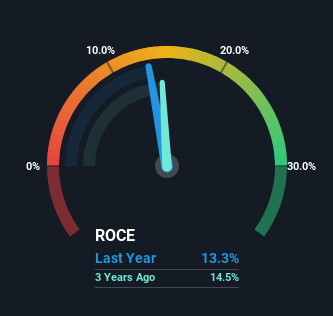- China
- /
- Healthcare Services
- /
- SHSE:600713
Returns On Capital At NanJing Pharmaceutical (SHSE:600713) Paint A Concerning Picture
If you're looking for a multi-bagger, there's a few things to keep an eye out for. Firstly, we'd want to identify a growing return on capital employed (ROCE) and then alongside that, an ever-increasing base of capital employed. If you see this, it typically means it's a company with a great business model and plenty of profitable reinvestment opportunities. In light of that, when we looked at NanJing Pharmaceutical (SHSE:600713) and its ROCE trend, we weren't exactly thrilled.
What Is Return On Capital Employed (ROCE)?
Just to clarify if you're unsure, ROCE is a metric for evaluating how much pre-tax income (in percentage terms) a company earns on the capital invested in its business. To calculate this metric for NanJing Pharmaceutical, this is the formula:
Return on Capital Employed = Earnings Before Interest and Tax (EBIT) ÷ (Total Assets - Current Liabilities)
0.13 = CN¥1.5b ÷ (CN¥32b - CN¥20b) (Based on the trailing twelve months to June 2024).
Thus, NanJing Pharmaceutical has an ROCE of 13%. On its own, that's a standard return, however it's much better than the 8.7% generated by the Healthcare industry.
Check out our latest analysis for NanJing Pharmaceutical

While the past is not representative of the future, it can be helpful to know how a company has performed historically, which is why we have this chart above. If you're interested in investigating NanJing Pharmaceutical's past further, check out this free graph covering NanJing Pharmaceutical's past earnings, revenue and cash flow.
What Can We Tell From NanJing Pharmaceutical's ROCE Trend?
When we looked at the ROCE trend at NanJing Pharmaceutical, we didn't gain much confidence. Over the last five years, returns on capital have decreased to 13% from 19% five years ago. However it looks like NanJing Pharmaceutical might be reinvesting for long term growth because while capital employed has increased, the company's sales haven't changed much in the last 12 months. It may take some time before the company starts to see any change in earnings from these investments.
On a related note, NanJing Pharmaceutical has decreased its current liabilities to 64% of total assets. That could partly explain why the ROCE has dropped. Effectively this means their suppliers or short-term creditors are funding less of the business, which reduces some elements of risk. Since the business is basically funding more of its operations with it's own money, you could argue this has made the business less efficient at generating ROCE. Keep in mind 64% is still pretty high, so those risks are still somewhat prevalent.
The Key Takeaway
To conclude, we've found that NanJing Pharmaceutical is reinvesting in the business, but returns have been falling. And with the stock having returned a mere 22% in the last five years to shareholders, you could argue that they're aware of these lackluster trends. Therefore, if you're looking for a multi-bagger, we'd propose looking at other options.
If you'd like to know more about NanJing Pharmaceutical, we've spotted 2 warning signs, and 1 of them makes us a bit uncomfortable.
While NanJing Pharmaceutical may not currently earn the highest returns, we've compiled a list of companies that currently earn more than 25% return on equity. Check out this free list here.
Valuation is complex, but we're here to simplify it.
Discover if NanJing Pharmaceutical might be undervalued or overvalued with our detailed analysis, featuring fair value estimates, potential risks, dividends, insider trades, and its financial condition.
Access Free AnalysisHave feedback on this article? Concerned about the content? Get in touch with us directly. Alternatively, email editorial-team (at) simplywallst.com.
This article by Simply Wall St is general in nature. We provide commentary based on historical data and analyst forecasts only using an unbiased methodology and our articles are not intended to be financial advice. It does not constitute a recommendation to buy or sell any stock, and does not take account of your objectives, or your financial situation. We aim to bring you long-term focused analysis driven by fundamental data. Note that our analysis may not factor in the latest price-sensitive company announcements or qualitative material. Simply Wall St has no position in any stocks mentioned.
About SHSE:600713
NanJing Pharmaceutical
Engages in the pharmaceutical wholesale and retail businesses in China.
Adequate balance sheet second-rate dividend payer.
Similar Companies
Market Insights
Community Narratives



